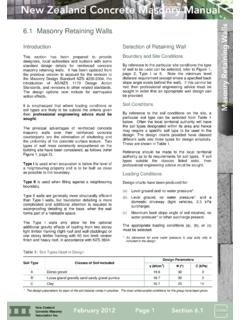Transcription of 2.1 Fire Resistance - NZCMA
1 fire Resistance Introduction (I) are universally recognised to define fire protection. Time periods ( fire ratings) are attributed Concrete masonry is generally considered to have to each of these functions to designate the level of good fire Resistance since it is non-combustible ( fire performance. it does not burn), absorbs heat only slowly, and does not give off toxic fumes or smoke. As it is a poor The overall fire Resisting Rating of an element is conductor of heat and has a high heat capacity, termed FRR, thus a FRR of 90/90/90 requires a 90. concrete is used to protect other construction minute rating for each of stability, integrity, and materials such as steel and timber from fire .
2 In insulation. addition, it is this slow heat absorption which enables concrete to act as an effective fire shield to Stability protect adjacent spaces and contents, as well as itself from internal fire damage. Stability is the load bearing capacity provided by the primary elements within a firecell and includes These inherent properties, combined with the elements which are part of the structural frame as appropriate design of structural elements, ensure well as those providing support to other fire rated concrete performs well in fire . elements. However, there are some issues surrounding The Stability fire rating (R) is based upon the time an concrete's performance in fire which require careful element can withstand a standard fire test and retain consideration.
3 This bulletin outlines these issues, its loadbearing capacity while allowing for a level of while providing general guidance to designers and superimposed load. specifiers on the design of concrete structures against fire . Integrity Integrity is the flame arresting separation typically Principles of fire Protection provided by secondary elements, internal walls, to protect people and goods from flames, harmful smoke and hot gases. Primary elements, along with The first and most important objective in fire secondary elements, are also rated for integrity. protection is to safeguard the lives of any people who are in the structure which is on fire , and enable The time during which an element's fire separation them to exit the building quickly and safely.
4 Capability is maintained is determined by the Secondly, the structure must be designed to allow tightness of joints to limit smoke and gas enough time for fire fighters to safely carry out any penetration. search and rescue operations, along with firefighting operations. Thirdly, there are requirements to Most casualties suffocate in a fire because of the protect other property under the New Zealand smoke rather than burn in the flames. Concrete does Building Code (NZBC), these include preventing the not develop smoke during fire . fire from spreading as well as preventing hazardous materials at the fire site entering waterways.
5 Insulation Concrete masonry is commonly used to provide stable firecells in large industrial or multi-storey Insulation is the heat shielding capability provided by buildings as a means to contain a fire and prevent it either primary or secondary elements. It is applied spreading to the whole building. This is also called to fire separations where the transmission of heat fire separation or compartmentation. Concrete walls may endanger occupants on the non-exposed side reduce the spread of fire horizontally and concrete or cause fire to spread to other fire compartments. floors vertically. Concrete provides the opportunity The fire rating is the time defined by a maximum to install safe separating structures in a reliable and permitted rise of temperature on the non-exposed economical way.
6 Side. fire performance is the ability of a particular structural element (as opposed to any particular Active versus Passive fire Protection building material) to fulfil its designed function for a period of time in the event of a fire . The three Concrete's and concrete masonry's inherent fire functions of Stability (R), Integrity (E) and Insulation Resistance provides a robust passive protection New Zealand Concrete Masonry Association Inc. system that usually requires no additional fireproof is argued that compartmentisation passive rules linings or coatings. should not be relaxed when active systems such as sprinklers are included.
7 Sprinklers may well reduce fire protection for lightweight construction often contents fire loss for the owner and are therefore relies on active protection systems such as desirable from an insurance point of view. If they do sprinklers. However, the robustness of sprinkler not work then it is a statistical risk for insurers. systems following an earthquake has been questioned in light of the vulnerability of reservoir water supply and the significant risk of a post- Concrete Performance in fire earthquake fire . Many reservoirs are fitted with auto-shut valves for earthquake events. At temperatures of 150 C upwards there is some loss of water from the silicate hydrates in concrete, The integrity of fire linings following an earthquake while temperatures above 300 C result in the loss of has also been brought into question by BRANZ.
8 Bound water, and in turn strength. research, particularly where dislodged plaster filling at joints, resulting from seismic shaking, compromised the integrity by 40%. In addition, it While concrete may undergo strength loss at has also been found that poor workmanship in temperatures 300 C and above, the main losses are retrofitting of structures after installation of services not apparent until above 500 C. Even though flame through lightweight fire rated elements has temperatures are up to double 500 C, the compromised subsequent levels of fire protection. temperature of the internal concrete remains Furthermore, fire linings/paint could be damaged by relatively low as a result of concrete's slow heat impact hit by the edge of carried through items absorption.
9 Therefore, only intense fires of long or furniture. duration may cause any weakening of concrete structures. It is fashionable to pour scorn on the old fashioned . approach for fire containment by using a masonry Cement type can have some influence on strength wall between occupancies. Reliance must be loss. Cements with fly ash and ground granulated placed in "up market active systems" if one is to blast furnace slag have lower quantities of free remain in fashion. calcium hydroxide which can give reduced hydration loss on heating, and consequently lower strength The Great fire of London, 1666, was one event that loss.
10 Led to the use of masonry walls between occupancies. In 1940 the fire -bombing of cities such The fire rating of a concrete is also influenced by the as London put the masonry system to the ultimate aggregate type. This results partly from the test, , containment of fire since for the most part coefficient of thermal expansion between the little water was available. aggregate and the cement paste being different, particularly at higher temperatures. New Zealand in common with other countries has embarked on a series of fire protection code The thermal conductivity of concrete depends on the changes. By and large, previous codes have been nature of the aggregate, porosity and moisture claimed to be ultra conservative and too prescriptive content.





